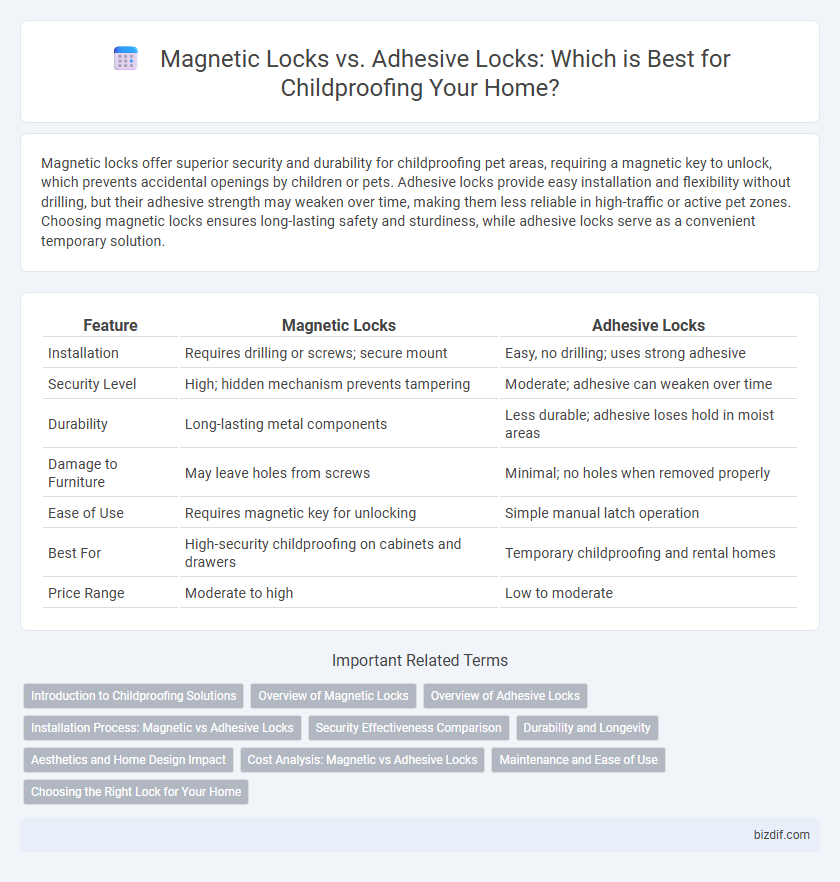Magnetic locks offer superior security and durability for childproofing pet areas, requiring a magnetic key to unlock, which prevents accidental openings by children or pets. Adhesive locks provide easy installation and flexibility without drilling, but their adhesive strength may weaken over time, making them less reliable in high-traffic or active pet zones. Choosing magnetic locks ensures long-lasting safety and sturdiness, while adhesive locks serve as a convenient temporary solution.
Table of Comparison
| Feature | Magnetic Locks | Adhesive Locks |
|---|---|---|
| Installation | Requires drilling or screws; secure mount | Easy, no drilling; uses strong adhesive |
| Security Level | High; hidden mechanism prevents tampering | Moderate; adhesive can weaken over time |
| Durability | Long-lasting metal components | Less durable; adhesive loses hold in moist areas |
| Damage to Furniture | May leave holes from screws | Minimal; no holes when removed properly |
| Ease of Use | Requires magnetic key for unlocking | Simple manual latch operation |
| Best For | High-security childproofing on cabinets and drawers | Temporary childproofing and rental homes |
| Price Range | Moderate to high | Low to moderate |
Introduction to Childproofing Solutions
Magnetic locks provide a secure and hidden childproofing solution that requires a special key to open, ensuring cabinets and drawers stay inaccessible to children. Adhesive locks offer a simpler, tool-free installation by sticking directly onto surfaces, making them ideal for temporary or rental spaces. Both options enhance home safety by effectively restricting access to potentially hazardous areas.
Overview of Magnetic Locks
Magnetic locks provide a secure childproofing solution that uses strong magnets to prevent children from opening cabinets and drawers, ensuring safety without damaging furniture. These locks are installed inside cabinets, remaining hidden from view while allowing easy access for adults with a magnetic key. Durable and reliable, magnetic locks offer a convenient, non-invasive alternative to adhesive locks, which may weaken over time and leave residue.
Overview of Adhesive Locks
Adhesive locks provide a convenient, drill-free option for securing cabinets and drawers, ideal for renters or those seeking non-permanent childproofing solutions. These locks use strong, durable adhesive pads that can withstand pulling forces while preserving furniture surfaces. Their easy installation and removal make them a popular choice for parents aiming to protect children from accessing hazardous items without damaging household items.
Installation Process: Magnetic vs Adhesive Locks
Magnetic locks require precise alignment during installation, often involving screws and drilling to securely attach components to cabinets or drawers, ensuring durable childproofing. Adhesive locks offer a simpler installation process by using strong, industrial-grade adhesives that stick directly to surfaces without tools, making them ideal for renters or those avoiding damage to furniture. While magnetic locks provide a more robust, tamper-resistant solution, adhesive locks deliver quick, tool-free installation with moderate security.
Security Effectiveness Comparison
Magnetic locks offer superior security effectiveness compared to adhesive locks due to their tamper-resistant mechanisms and strong holding force, making them ideal for preventing access to cabinets and drawers. Adhesive locks, while easy to install and convenient, tend to have weaker bonds that can be compromised by persistent force or moisture, reducing their reliability in high-risk areas. For optimal childproofing, magnetic locks provide enhanced durability and security, ensuring better protection against accidental access by children.
Durability and Longevity
Magnetic locks offer superior durability and longevity compared to adhesive locks because they are typically made from robust metal components designed to withstand repeated use and environmental wear. Adhesive locks rely on bonding strength to surfaces, which can weaken over time due to temperature changes and surface contamination, reducing their effectiveness. For long-term childproofing, magnetic locks provide a more reliable and maintenance-free solution, ensuring consistent security.
Aesthetics and Home Design Impact
Magnetic locks offer a sleek, concealed design that integrates seamlessly with modern home aesthetics, preserving cabinetry and furniture appearances without visible hardware. Adhesive locks, while easy to install, often detract from the overall design due to their bulky, external placement. Choosing magnetic locks enhances safety without compromising the visual harmony of interior spaces.
Cost Analysis: Magnetic vs Adhesive Locks
Magnetic locks typically have a higher upfront cost, ranging from $15 to $30 per lock, compared to adhesive locks, which usually cost between $5 and $15 each. Installation costs for magnetic locks can be higher due to the need for precise alignment and possible drilling, while adhesive locks offer a cost-effective, tool-free installation ideal for budget-conscious families. Over time, magnetic locks may provide better durability and fewer replacements, potentially offsetting their initial expense compared to adhesive locks that might lose adhesion and require more frequent replacement.
Maintenance and Ease of Use
Magnetic locks offer durable performance with minimal maintenance, requiring only occasional battery replacement to ensure consistent functionality. Adhesive locks provide easy installation without tools but may need frequent adhesive replacement to maintain secure attachment, especially in high-humidity environments. Both types prioritize child safety, but magnetic locks typically offer smoother operation and longer-lasting reliability for busy households.
Choosing the Right Lock for Your Home
Magnetic locks provide superior security by requiring a magnetic key to unlock, making them ideal for households seeking tamper-proof solutions. Adhesive locks offer easy installation on various surfaces without drilling, perfect for renters or temporary setups. Selecting the right childproof lock depends on your home's surface type, desired security level, and ease of use for caregivers.
Magnetic locks vs adhesive locks Infographic

 bizdif.com
bizdif.com